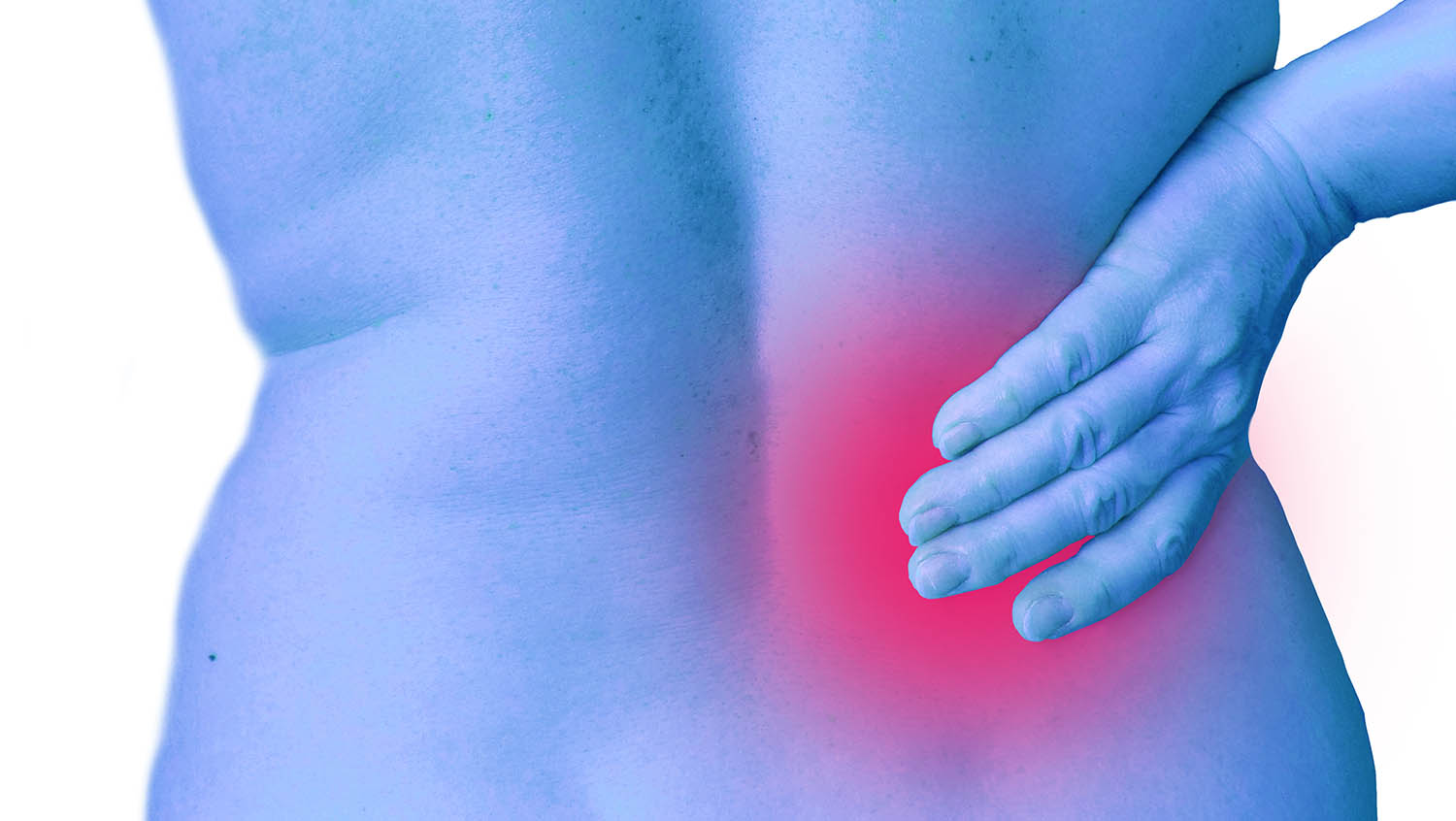If you’re suffering from back pain and wondering if your condition makes you eligible for Social Security disability benefits, there’s no one clear answer. As with so many types of conditions, a lot depends on the extent and duration of back pain and how it affects someone’s day-to-day life and ability to earn a living.
As with any disability, to qualify for benefits, you need to go through the entire process of establishing and proving a documented disability. This entails providing medical documentation of debilitating back pain that has lasted for at least a year. While acute back pain associated with falls or injuries usually heals within three weeks, chronic back pain that is pervasive and prolonged is a completely different story. A successful disability benefits claim often will show a specific diagnosis for the condition leading to chronic back pain.
6 Common Causes of Back Pain
- Disc problems
- Inflammatory issues
- Skeletal irregularities
- Injuries
- Osteoporosis
- Nerve damage
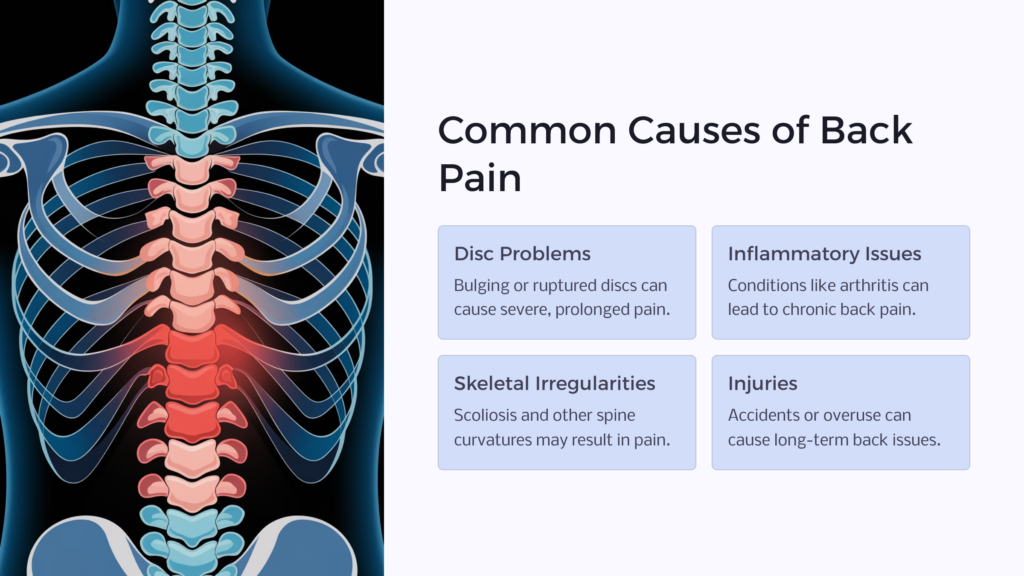
If you have chronic back pain, the last thing you want to worry about is money. Add in doctor’s appointments, physical therapy, laboratory tests, and never-ending travels to specialists, and your life quickly becomes very complicated. On top of that, you may need to file a claim for disability benefits, which can be a daunting process.
Chronic back pain is the most common disability application the Social Security Administration (SSA) deals with each day. In fact, statistics reveal that back pain is a leading cause for someone to miss work, and bone degeneration is the primary disability for people under forty-five years old. Back pain can vary from a dull, nagging ache to severe pain preventing you from even getting out of bed.
Chronic back pain can stem from a wide variety of causes and medical issues, including those listed below. Some of them are natural results of aging, while others can be brought on suddenly by accident or injury.
Back pain can be exhausting and frustrating – and sometimes it can be classified as a disability eligible for benefits under the Social Security Disability Insurance program. Back pain is one of the most common reasons behind both doctor visits and missed workdays, and it is a top cause of disability throughout the world.
The Social Security Administration sees thousands of claims for back pain disability every year and is only able to approve some of them. As with any disability claim, an application must show SSA reviewers that the back pain in question is chronic and debilitating, to the point where a claimant cannot work. Though the SSA does not work from a specific designation for general back pain, its standard list does include several conditions that typically result in back pain, like some of the ones discussed below. A successful claim often will be able to show a documented diagnosis of one of these sources of chronic back pain.
The Essentials When Applying for Disability Due to Back Pain
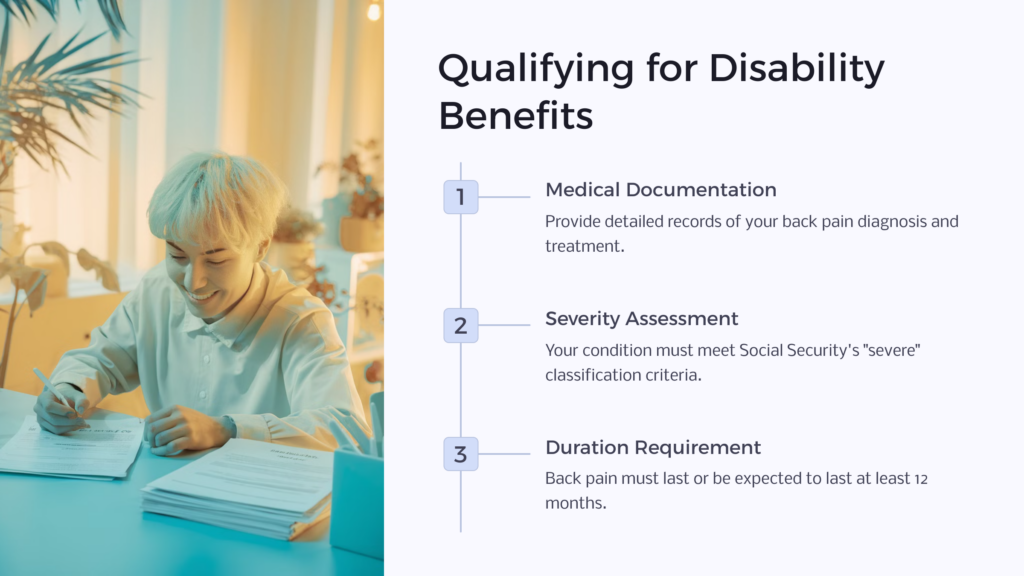
Documentation is Key
For a successful Social Security or Supplemental Security Income disability application for back pain, your diagnosis and limitations must be well documented. Your condition must also fall into Social Security’s “severe” classification. To receive disability from the SSA, your back pain should be diagnosed as a specific medical problem, such as a herniated disk, nerve root compression, or sciatica, for example. Even if you have a herniated disk, medical personnel should determine that the condition is not subject to rectifying treatment and that it also meets their “chronic” definition. This is in contrast to other types of back pain.
For example, misuse or overuse of back muscles is a frequent complaint as people age, but such back pain resulting from normal aging will not be approved for a disability claim. SSA understands that most back pain will resolve itself within a few weeks or a few months, and back pain is a very common complaint as people age. Accordingly, they essentially expect you to deal with it as you move toward retirement age.
What is Chronic Back Pain?
Chronic pain is pain that is not resolved within the usual recovery time frame for an injury—perhaps three to six months or pain that arises from a degenerative condition of the spine and persists. As unlikely as it may seem, back conditions are sometimes difficult to diagnose. Much of the time, a diagnosis has to be based on your description of the pain, which is very one-sided at best and does not always lend itself to rigorous scientific examination with medical findings. Lack of a firm diagnosis can make it very hard, nearly impossible, to get a determination that you are disabled. This is due to Social Security’s definition of disability, which says disability is “the inability to engage in any substantial gainful activity by reason of any medically determinable physical or mental impairment which can be expected to result in death or which has lasted, or can be expected to last, for a continuous period of not less than twelve months.”
For this reason, initial claims and even reconsideration appeals are often denied. The result is that back pain claims often end up in a second appeal, which is a hearing before an administrative law judge.
Judges will look at a doctor’s reports and any test results, of course; but they must go further and act more like a court jury deciding a case, meaning that they will also examine your work history, your previous and current statements concerning your condition, any witness statements, and photographs, or video footage.
They will also want to see a detailed record of your attempts for treatment and any results. Such treatment might include physical therapy, yoga, exercises, medications, supplements, surgery, chiropractic or acupuncture treatments, bioelectric therapy, or ultrasound treatments. For instance, the hearing official might be interested in knowing if you have received any cortisone shots, how effective they were, how long relief lasted, and if any side effects occurred.
Specifically, what SSA is looking for is a “medically determinable” condition, which would distinguish your condition from a chronic back pain normally associated with aging or a short-term injury. Examples of possible precipitating events could include heavy lifting, improper lifting, an accident, a fall, or back strain caused by a sports activity. Such cases would usually heal within a matter of weeks, which would be less than the required one-year time frame and would therefore not be allowed.
6 Common Causes of Back Pain
Let’s explore in more detail some of the most common causes of back pain that often lead to disability. Keep in mind that many of these conditions are affected by factors like age, weight, lifestyle habits like diet and exercise, and genetic predispositions.
Disc Problems
The discs in our backs are more important than you might think. The human back is a complex collection of bones, muscles, ligaments, tendons, and the all-important, cartilage-like disks that sit between your vertebrae. Discs provide a necessary cushion between our spinal vertebrae – and because these discs are soft, they can bulge out of place or rupture, which usually means they then put pressure on surrounding nerves. All of this can happen with or without back pain, but back pain associated with disc problems can be severe and prolonged.
Some people also may suffer from degenerative disc disease, which causes those spinal discs to break down over time. This condition can usually be diagnosed with X-rays or other imaging techniques. As the discs between vertebrae break down and become thinner over time, pressure increases on the facet joints of the spine. This causes more friction, more breakdown, and potentially more pain. Degenerative disc disease is the leading cause of disability in the nation for people aged 45 or younger.
Inflammatory Issues
Inflammatory disorders can often lead to debilitating back pain. For example, rheumatoid arthritis, which is an autoimmune disease, causes the immune system to attack the lining of the body’s joints – the synovium. Though more common in other parts of the body, rheumatoid arthritis can affect the joints of the back and neck.
Osteoarthritis is often the culprit behind chronic lower back pain, sometimes even leading to spinal stenosis, which is the consistent narrowing of the space around the spinal cord – depending on its severity, spinal stenosis can put extra pressure on the spinal cord and surrounding nerves. While lower back pain and neck pain are most common, osteoarthritis also can lead to inflammation and pain in the hips and other parts of the body.
Spinal arthritis involves inflammation in the facet or sacroiliac joints of the spine and it can cause problems where tendons and ligaments attach to the bones of the spine. Stiffness and chronic pain are the leading symptoms of spinal arthritis, which often lead to functional limitations that interfere with the ability to work.
A whole series of separate inflammatory disorders called spondyloarthritis also can contribute to chronic back pain. Some of these disorders include psoriatic arthritis, ankylosing spondylitis, reactive arthritis, and enteropathic arthritis, just to name a few. These diseases are known to affect not only the joints but also the places where tendons and ligaments connect to bones. They can occur at several locations throughout the body, including the back.
Skeletal Irregularities
Scoliosis is a skeletal irregularity that causes curvature of the spine. This curvature can be mild or pronounced and may result in chronic back pain, depending on the severity of the curvature. A condition called lordosis is an abnormally exaggerated arch in the lower back that also can be painful for some people, while kyphosis constitutes an excessive outward curvature of the spine. Some people also may battle spina bifida, which is the incomplete development of the spinal cord and/or its outer, protective covering. This condition may result in malformed vertebrae, pain, or abnormal sensation in the back and, in the most severe cases, paralysis.
Injuries
Many types of injuries can cause chronic back pain. In fact, work-related back injury is the leading occupational hazard in the nation. Of course, there’s a big difference between short-term, acute back injuries and the types of injuries that might make someone eligible for Social Security disability benefits.
Short-term back injuries might be caused by lifting something improperly or lifting an object that’s simply too heavy, falling, or even making a sudden, abrupt movement. It’s easy to strain muscles in the lower or upper back through overuse or accident, which then leads to short-term pain that most often goes away with rest and time, and/or can be managed with over-the-counter pain relief medications like acetaminophen and ibuprofen. These are not the types of back pain that generally result in an accepted claim for Social Security disability benefits.
Longer-term injuries usually have more sinister causes – like car wrecks, major sports injuries, or even truck accident injuries. These types of injuries can result in much longer-term, chronic pain. Severe injuries with long-lasting and debilitating effects that can keep someone out of work for at least a year or more are significantly more likely to lead to SSA approval of disability benefits. Traumatic injuries not only have the potential to damage muscles, ligaments, and tendons, but they also may directly damage vertebrae, compress the spine, and cause discs to bulge or rupture.
Osteoporosis
Osteoporosis is a progressive disease that, over time, reduces bone density and strength – because bones are living tissues, they are constantly being broken down and regenerated. But when osteoporosis is present, the regeneration of new tissue can’t keep up with the breaking down of old tissue. Bone density increases in our younger years, as bone mass is generated faster than it is broken down, but most people reach their peak bone density around age 30. At that point, the amount of bone density you’ve “built up” in earlier years is a key determinant of whether you’ll develop osteoporosis and how severe symptoms will be. The more density you’ve built up over time, the less likely you’ll be to exhibit symptoms of osteoporosis later in life.
In and of itself, osteoporosis may not be painful, but in many cases, osteoporosis can lead to bones becoming porous and fragile. This increased vulnerability can result in compression fractures of the vertebrae in the lower back that can be profoundly painful. Compression fractures can cause sudden, sharp pain that flares when standing or walking, along with trouble twisting the spine, loss of height, and curvature of the spine. These fractures can happen even when carrying out daily activities that most people don’t think of as dangerous – picking up a basket full of laundry, coughing, carrying in the groceries, or bending to get in and out of a car.
Nerve Damage
Interruptions to normal nerve activity can result in severe back pain. Nerve compression, for example, can cause significant loss of both range of motion and reflexes, along with pain, which can make many occupations difficult. One of the most common nerve-associated conditions is called sciatica, which is usually caused by a bulging or ruptured disk pressing on the sciatic nerve. This can result in sharp, shooting, or burning pains that travel down the back and buttocks down through the legs.
Another specific nerve disorder is cauda equina syndrome, which affects the bundle of spinal nerve roots at the base of the spinal cord, leading to dull pain and sometimes numbness in the lower back and perhaps other areas of the body as well, like buttocks and thighs. Cauda equina syndrome is typically caused by a disc that ruptures and then presses directly on the lumbar and sacral nerve bundles. In this situation, if left untreated, the syndrome can lead to permanent neurological damage.
If someone suffers from spondylolisthesis, this can lead to an individual vertebra slipping out of place, pinching nerves as they branch out from the spinal column and resulting in chronic back pain.
Back Pain as a Disability
Back pain affects thousands of Americans every year. It’s often debilitating and is a leading cause of work absences and applications for Social Security disability benefits. Studies show that 20% of people who initially suffer from acute back pain eventually develop chronic and pervasive back pain.
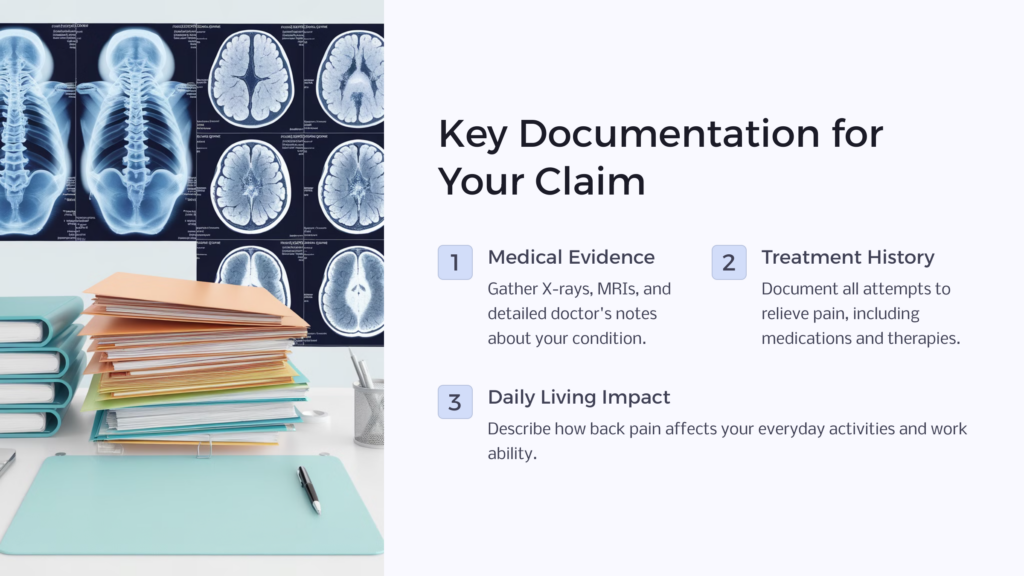
Documentation You Need to Receive Disability for Back Pain
Doctors and Tests
Medical proof is best—verifiable proof from a doctor and test results from MRIs and X-rays showing that your pain results from something abnormal in the spinal column or spinal canal. For instance, an X-ray showing that a vertebra is fractured, an MRI indicating degeneration of bone in the spine, especially with nerve impingement, or a CT scan identifying a severely herniated disc, this could be the proof they want.
Your doctor’s records are very important in the claim process, and such notes must be very detailed. They should show your level of pain, rate of recurrence, triggering events, relief strategies, and a well-formed timeline of the entire process. It is vital that you show continuing attempts to relieve this chronic pain.
The physician should also list how this disability is affecting your normal daily activities. Because of these requirements, you should make certain that you have a doctor who is experienced in dealing with patients suffering from back pain.
Activities of Daily Living
You may also be required to fill out an Activities of Daily Living (ADL) form, which describes your limitations throughout your normal day. Remember not to exaggerate your problems because you do not want to damage your credibility with the SSA. Answer carefully and truthfully.
You need to fairly assess your daily chores and determine if you can no longer perform some of these or if they take longer to complete than normal. Is your social schedule the same or has the pain kept you housebound and away from friends and relatives? Has your pain changed your psychological state? Do you now have troubling moods or depression that has alienated friends, neighbors, and relatives? Does the pain stop you from thinking clearly or remembering details? Any of these problems could have a direct effect on your ability to maintain any full-time job you might qualify for.
SSA may also contact your friends and relatives and ask them specific questions about your normal activities and if your pain is noticeable to them. The examiner may turn to one of their medical consultants for another opinion of the case. Unfortunately, these consultants will only examine available records to reach their conclusions. Many facts may escape them because you would not be interviewed.
Spinal Problems Recognized for Benefits by SSA
Social Security’s Blue Book has a listing of conditions that qualify for automatic approval for disability benefits based on medical condition alone without evaluation of transferable work skills or education, but chronic pain is not included. Nonetheless, a number of diseases and medical problems associated with chronic pain could pave the road to disability benefits: chronic renal disease, inflammatory arthritis, inflammatory bowel disease, somatoform disorders, and diseases of the neurological system all produce pain and could be the basis for receiving disability benefits. And, certain spinal conditions producing pain are listed.
Three of the categories of spinal problems that could lead to being approved for disability benefits based on a listing in the Blue Book are:
- Stenosis
- Arachnoiditis
- Nerve Root Compression
SSA provides examples of spinal cord compression or nerve root compression that could cause moderate or chronic pain all the way up to paralysis:
- Herniated, slipped, prolapsed disc (herniated nucleus pulposus [HNP])
- Facet arthritis
- Vertebra fracture
- Degenerative disc disease (DDD)
All of these, however, must be accompanied by certain findings to meet the listings.
Is Degenerative Disc Disease a Disability?
If you’re dealing with degenerative disc disease (DDD) and finding it increasingly challenging to work, you may be eligible for Social Security Disability Insurance (SSDI) benefits. However, securing these benefits requires proving your eligibility with:
1. Medical Evidence
This includes medical records, diagnostic test results (such as X-rays, MRIs, or CT scans), and documentation from healthcare professionals describing the severity of your condition, limitations, and treatment history. Ensure that your medical evidence is up-to-date, clear, and well-documented.
2. Work History
Demonstrating that your degenerative disc disease prevents you from engaging in substantial gainful activity is important for SSDI approval. You need to show that your condition significantly limits your ability to perform tasks required by your previous occupation or any other job that you could reasonably be expected to do. Providing detailed work history, job descriptions, and explanations of how your condition interferes with work-related activities can strengthen your claim.
3. Functional Limitations
Clearly describing your functional limitations is crucial. Explain how your degenerative disc disease affects your ability to sit, stand, walk, lift, bend, or perform other daily activities required for employment. Be specific about the duration, frequency, and intensity of pain, as well as any limitations on your ability to concentrate or complete tasks due to pain or medication side effects. You may want to consult with your healthcare provider to assess your functional limitations accurately.
4. Treatment Compliance
Following prescribed treatment plans and demonstrating compliance with medical advice is essential. Failure to adhere to treatments without valid reasons might negatively impact your SSDI claim. Keep a record of all treatments, therapies, medications, and their outcomes. If you have explored various treatments and can explain why they were unsuccessful, it can strengthen your case.
5. Supportive Statements
Gathering statements from healthcare providers, physical therapists, and other professionals involved in your treatment can bolster your SSDI claim. Their objective observations, assessments, and opinions regarding your condition, limitations, and prognosis carry weight in the evaluation process. Additionally, statements from family, friends, or coworkers who can attest to the impact of your condition on your daily life may provide valuable supporting evidence.
Remember, the SSDI application process can be complex and time-consuming. It’s recommended to seek guidance from professionals such as disability attorneys or advocates who specialize in SSDI claims. They can help you navigate the process, ensure you have the necessary documentation, and present a strong case on your behalf.
Residual Functional Capacity
If you do not qualify for benefits under the listings, your claim will be evaluated to determine your limitations and capacities. This is done by determining your medical limitations and considering them as related to the demands of your former occupations and potential new occupations. One tool for determining functional limitations is a Residual Functional Capacity (RFC) assessment, which may be completed by Social Security doctors based on your medical records or an RFC might be completed by your physician or a consulting physician. The RFC form is used to record your ability to work full-time and will also assess your current physical abilities, such as the following:
- Amount of weight you could carry and lift
- Your ability to walk and how far
- How long you could sit
- Your ability to push and pull
- How long you could maintain a standing position
- Your ability to bend over and lift
- Your ability to reach over your head
To bolster your case, have your doctor, preferably a specialist in back pain and injury, complete an RFC. The more functional limitations noted on the form, the better your case for winning a disability claim.
Examples of Functional Limitations
- Unable to remain seated for 6 hours in a normal workday
- Unable to stand for 2 hours a day
- Unable to walk one block without stopping
- Need to lie down during the day
- Unable to carry 10 pounds intermittently during a workday
- Must keep one or both legs elevated during the day
- Maintain Your Credibility
When you have to appeal up to a hearing, the administrative law judge may also consider your personal statements to determine if they are believable or if you seem to be exaggerating your claims. A psychiatric consultation could also be ordered for a better picture of your mental health and to assess whether your claims are inconsistent with what is expected with your particular condition.
To gauge your credibility, a hearing officer or judge may consider the following:
- Your statements
- The intensity of your pain, the location, and how long the pain and effects last
- Triggering incidents
- Effectiveness of medications, dosage, and any side effects
- Self-treatment strategies and their effectiveness, such as sleeping on a board or icing or applying a heat pack to the painful area
- Employer statements
- Employment history and how the pain affected it
- Witness statements
- Medical records, including your doctor’s records and prognosis
- The history and results of any therapy
- Any indications of untruthfulness, such as stating in the records that you cannot sit more than a few minutes, but you remain seated during a long interview with an examiner or at the hearing
- How compatible all your statements are with existing records
- An examination of the history of your condition and how it has changed over time
These findings could well be critical for approving or denying your claim. If you have a long history of emergency room visits, examinations by different doctors and any therapeutic procedures, such as acupuncture, physical therapy, medication trials, and different dosages, your credibility may be boosted, which can only help your case.
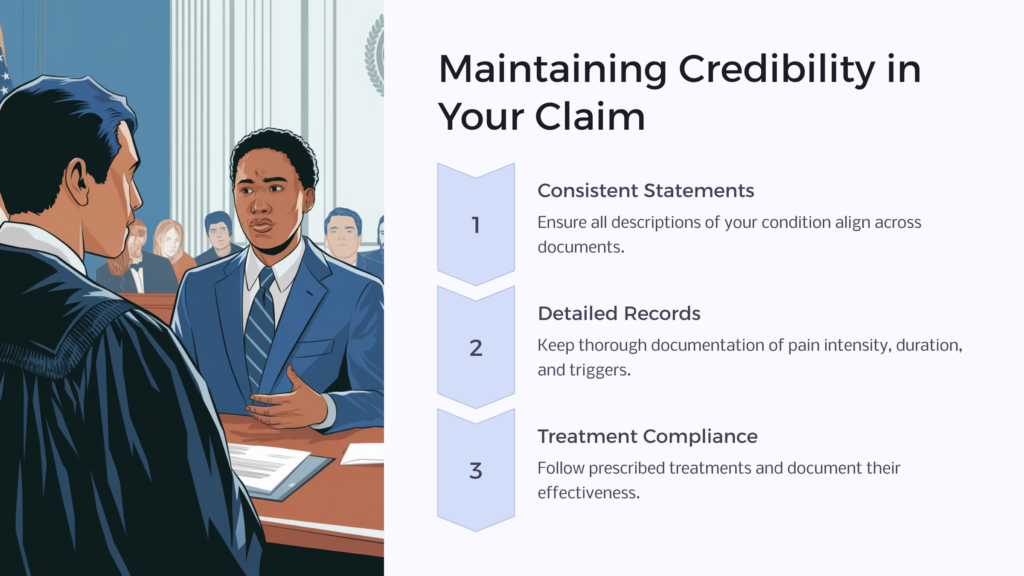
Claims and Appeals for Back Pain
Although the Social Security Administration sees thousands of claims for disability benefits related to back pain every year, it is only able to approve a small portion of them. If you think you might qualify for disability benefits related to chronic back pain, talk with your doctor about the appropriate documentation and the merits of your claim. These claims are often difficult to win, so you may also think about whether you’d like to engage a disability attorney, especially if your claim is denied during the first round of review.
This attorney should have experience with the Social Security and Supplemental Security Income disability application and appeals processes. Also, check to be sure the attorney has successfully handled chronic back pain claims as well.
Your lawyer will review your claim file and help you prepare your appeal. If you must appeal a second time, the attorney will prepare you for the hearing. He or she will know when and how to cross-examine experts used by SSA to show why their conclusions are incorrect or too stringent. Such testimony could be particularly helpful for approving your benefits.
 Benefits.com Advisors
Benefits.com Advisors
With expertise spanning local, state, and federal benefit programs, our team is dedicated to guiding individuals towards the perfect program tailored to their unique circumstances.
Rise to the top with Peak Benefits!
Join our Peak Benefits Newsletter for the latest news, resources, and offers on all things government benefits.















